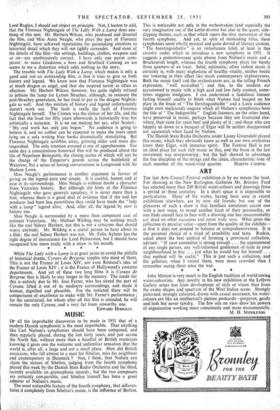ART
Tim last Arts Council Festival exhibition is by no means the least. For showing at the New Burlington Galleries Mr. Brinsley Ford has selected more than 200 British water-colours and drawings from a period of three centuries. In a short space it is impossible to particularise. Many of the works, having been seen in recent exhibitions elsewhere, are by now old friends, but one of the pleasures of such a show is that familiars sometimes accost one with a new voice, to reveal another facet of their personality, or one finds oneself face to face with a drawing one has unaccountably cut dead on other occasions and never truly seen. What gives the collection its peculiar value—apart from the quality of the exhibits— is that it does not pretend to balance or comprehensiveness. It is the personal choice of a mind of sensibility and taste. Ruskin, asked about the best method of forming a provincial collection, advised: "If your committee is strong enough . . . the appointment of any single person, any well-informed gentleman of taste in your neighbourhood to buy. . . just what he would buy for himself . . . that method will be useful." This is just such a collection, and the galleries, when I visited them, were more crowded than I remember seeing them since the war.
John Minton is very much in the English tradition of world-roving water-colourists. Any novelty in his new exhibition at the Leftvre Gallery arises less from development of style or vision than from the exotic shapes and spectrum of the West Indian scene. Strongly patterned, strongly coloured, drawn with casual assurance, his water- colours are like an intellectual's picture postcards—gorgeous, gaudy and lush but never tawdry. The few oils on view show'his powers of organisation working more consciously and more monumentally. M. H. MIDDLETON.


































 Previous page
Previous page